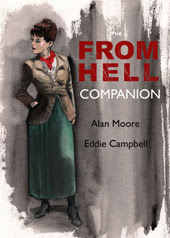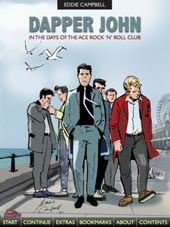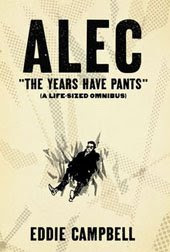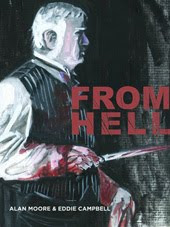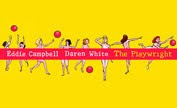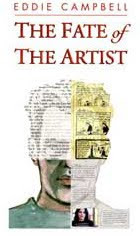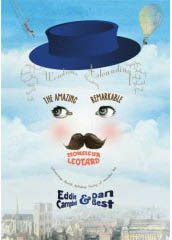As a laddie in the mid-sixties, I discovered Batman at the same time as everybody else, through the TV show. To cash in on the unusual attention suddenly bestowed upon this character, Signet Books had released three compilations of old stories, from the early 1950s, in paperback form in black and white on small pages with one or two panels per page. The TV show was fun but these books were a strange and wonderful transport to a city of the imagination. When you're a kid and don't have negotiate your own way about the place too often, everywhere is a place in your imagination.
Living on the suburban outskirts of Glasgow, Metropolis never worked for me. The Daily Planet Building was too much out of a retro cityscape like a display at the Worlds Fair. It belonged in the world of my older relatives. If you look at the very first Superman story, you can see that Shuster wasn’t really interested in the concrete urban jungle. When the hero is jumping up and away among the skyscrapers they hardly seem to be completely there. Joe isn’t excited enough to make them real, or to even put windows on them. By the time they had worked out the meaning of Superman, he was a representative of small-town America rather than its big cities. A cover from a 1950 Superboy in Les Daniels'
DC Comics: Sixty years of the World’s Favourite Comic Book Heroes is apposite. Superboy uses his x-ray vision to see the apple pie in the oven. “Oh dear,” says old white-haired Martha Kent, “I can’t keep any surprises from you, son”.

Gotham City, on the other hand, at least circa 1950, was very matter-of-fact, it felt not unlike the city I lived in and around. It was a big concrete playground compared to the absurd gothic nightmares of the more recent Batman movies, or the not quite convincing Hollywood set of the Tv show. Batman’s environment was a place of dark alleys where your parents might get mugged; of the unintelligible gibberish of yelling corner newsvendors; of hoodlums in zoot-suits whose thoughts we can never know; of perfectly dressed women with exotic scents haunting their slipstream. Everything here is impossibly huge and seen from the low point of view of a kid; and the larger world outside the city is hinted at via faux-exotic window displays of hula girls or festival parade floats of giant bananas. And on the outskirts of town where the long shadows reach, there are factories with open vats full of bubbling unspeakable chemicals.

By the time of the stories in these books (early 1950s) there is no sense of awe about Batman like there was at the beginning in 1939, a fact which I liked and still like. He is a familiar figure in his environment, just another element of the city. Celebrity heroes and celebrity villains. Symbols of order and crackpot criminality walking about in broad daylight. Villains were never underdressed in those days, but on the contrary, overdressed, like vaudevillian dandies. And those were used sparingly. The stories seemed real to my 10 year old brain. The far-fetched ones could be depended upon to turn out to be hoaxes, such as Dr Edward Arvin and
The Crime Predictor, a 1953 computer that was disturbingly about the size of the house next door. Or Lew Farnum,
The Man who Could Change Fingerprints, with its atmosphere of old noir movies that had me terrified for a few pages. Another story presents the problem of what Batman is to do about his mountain of fanmail. One of his letters is 20 feet tall and can only be read from the other side of the street.

The stories were often very nicley crafted (For most of them we may never know by whom). Check out
The Crazy Crime Clown (December 1952) which you can find in the DC collection
The Greatest Joker Stores Ever Told, in which the Joker feigns insanity so he can be locked up in the nut-house beside a bank-clerk who embezzled a million but can’t remember where he hid it. Batman permits himself to be locked up in the guise of Mad Minos the Mystic, turban and all, and the three of them share a ward with Christopher Columbus, Isaac Newton, Franz the Strangler and a guy whose delusion is that he believes himself to be Batman, and has the costume under his mattress to prove it. Or
The Joker’s Millions (February 1952), reprinted in the Les Daniels-Chip Kidd Batman book, a story full of clever irony which opens with the reading of the will of racketeer King Barlowe. "To Waxey Gates I leave the blackjack i took away from him after he tried to brain me when we were kids just out of reform school." The remainder of his millions he leaves to the Joker. Happy that he doesn't have to commit robberies any more, the Joker takes up his new life as a millionaire until a week later when he discovers that all the money is counterfeit. Then the taxman delivers the bill for 2 million inheritance tax. To save face the Joker has to commit crimes, but without leaving any hint that it's he who is behind them. Fate conspires against him; he robs the ticket office of a theatre without noticing that the show being performed is the opera Pagliacci, the famous story of a clown.

I loved these books. I coloured them with wax crayons. I kept them. Of course I grew up and I've been around real cities, but my memory of that fictional one sits there along with my memories of the real ones. The art in the stories is variously ghosted by Dick Sprang, Sheldon Moldoff and Lew Sayre Schwartz. After I received news of Lew's passing on Tuesday, I pulled these little books out once again, and I'm reminded of the words of Charlotte Bronte, who was writing about the great illustrator-engraver Thomas Bewick:
“…again we turn,
With fresh delight from the enchanted page,
Where pictured thoughts that breathe and speak and burn,
Still please alike our youth and riper age.”The above is adapted from my introduction to the interview I published with Lew back in 2002. Pictures are from The Joker's Journal, 1953, illustrated By Lew, written by who knows.
Read
Lew's obituary which I wrote for The Comics Journal.
earlier posts about lew Sayre SchwartzLabels: comic books 3
 This tin is filled with chopsticks. I can't recall ever using chopsticks at home, which is why I forgot about it until we had to empty the pantry to get the whole kitchen painted. Nor do I recall ever owning a bottle of Benedictine. I think the proprietor of the local liquor store gave me the tin on account of I was obviously in love with it and I was agood customer and his usual buyers of Benedictine would not have appreciated the art of Javier Mariscal quite as I do. You can find the image online as an art print, as I guess it also appeared as a poster. But here it is in its original setting. And here's a close up of the male figure on the left.
This tin is filled with chopsticks. I can't recall ever using chopsticks at home, which is why I forgot about it until we had to empty the pantry to get the whole kitchen painted. Nor do I recall ever owning a bottle of Benedictine. I think the proprietor of the local liquor store gave me the tin on account of I was obviously in love with it and I was agood customer and his usual buyers of Benedictine would not have appreciated the art of Javier Mariscal quite as I do. You can find the image online as an art print, as I guess it also appeared as a poster. But here it is in its original setting. And here's a close up of the male figure on the left.






